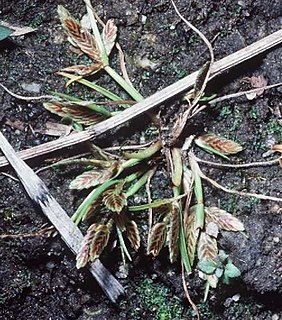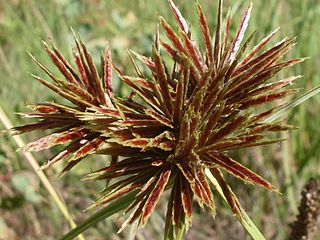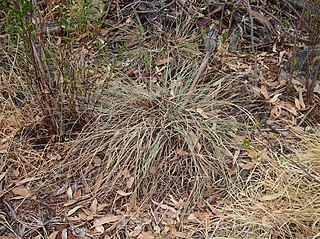
Cyperus haspan is a dwarf papyrus sedge in the Cyperaceae. It is widely distributed in tropical and subtropical regions in Africa, Madagascar, southern Asia, New Guinea, Australia, South America, West Indies, Central America, southern Mexico and the southeastern United States.

Cyperus polystachyos, also known as Pycreus polystachyos, and also called manyspike flatsedge in the USA, or bunchy sedge, coast flatsedge, many-spiked sedge or Texas sedge in Australia, is a herbaceous species in the family Cyperaceae, widespread in tropical and subtropical areas around the world, sometimes extending its range into temperate regions.

Cyperus eragrostis is a species of sedge known by several common names, including tall flatsedge, nutgrass, tall nutgrass, umbrella sedge, chufa, Earth almond, zula nuts, edible galingale and pale galingale.

Cyperus bipartitus, commonly known as slender flatsedge, river cyperus, or the shining flatsedge, is a common species of sedge. The name "slender flatsedge" also applies to Cyperus gracilis.

Cyperus difformis is a species of sedge known by several common names, including variable flatsedge, smallflower umbrella-sedge and rice sedge. This plant is native to southern Europe, most of Africa and Asia, and Australia, and it is naturalized in other areas of the world, including large parts of the Americas.

Cyperus laevigatus is a species of sedge known by the common name smooth flatsedge.

Cyperus alterniflorus, commonly known as umbrella flat-sedge, is a sedge of the family Cyperaceae that is native to Australia.

Cyperus betchei is a sedge of the family Cyperaceae that is native to Australia.

Cyperus compressus, commonly known as annual sedge, is a sedge of the family Cyperaceae that has a wide distribution throughout countries with warmer climates. It is found in tropical areas of Africa, Asia and the Americas.

Cyperus congestus, commonly known as dense flat-sedge or clustered flat-sedge, is a sedge of the family Cyperaceae that is native to southern Africa mostly in South Africa, Lesotho and Namibia.

Cyperus conicus is a sedge of the family Cyperaceae that is native to Western Australia.
Cyperus cunninghamii is a sedge of the family Cyperaceae that is native to Australia.
Cyperus gymnocaulos, commonly known as spiny flatsedge, is a sedge of the family Cyperaceae that is native to Australia.

Cyperus javanicus, also known as the Javanese flatsedge, is a sedge of the family Cyperaceae that is native to Indonesia and Australia.
Cyperus pulchellus is a sedge of the family Cyperaceae that is native to northern Australia, tropical Africa, northwest Madagascar and Southeast Asia.
Cyperus sexflorus is a sedge of the family Cyperaceae that is native to Australia.

Cyperus tenellus is a sedge of the family Cyperaceae commonly known as the tiny flatsedge.

Cyperus vaginatus, commonly known as stiff-leaf sedge or stiff flat-sedge, is a sedge of the family Cyperaceae that is native to Australia.
Cyperus vorsteri is a sedge of the family Cyperaceae native to southern Africa.
Cyperus zollingeri, commonly known as roadside flatsedge, is a sedge of the family Cyperaceae that is native to tropical areas of Australia, Africa and Asia.














